Day 2 of a four day Spring Tour in Norfolk. It was a bright day with lots of sunshine, but with a nagging blustery WSW wind, warm out of the wind but distinctly cooler in it.
Our first stop this morning was in Blakeney. As we got out of the minibus, a Lesser Black-backed Gull flew round over the quay and landed on the roof of a nearby house. We walked round to the side of the quay and up onto the bank overlooking the saltmarsh just beyond. It was already very breezy here and at first we couldn’t see anything with the small group of Brent Geese out in the middle, but after a while the Red-breasted Goose appeared out of the vegetation.
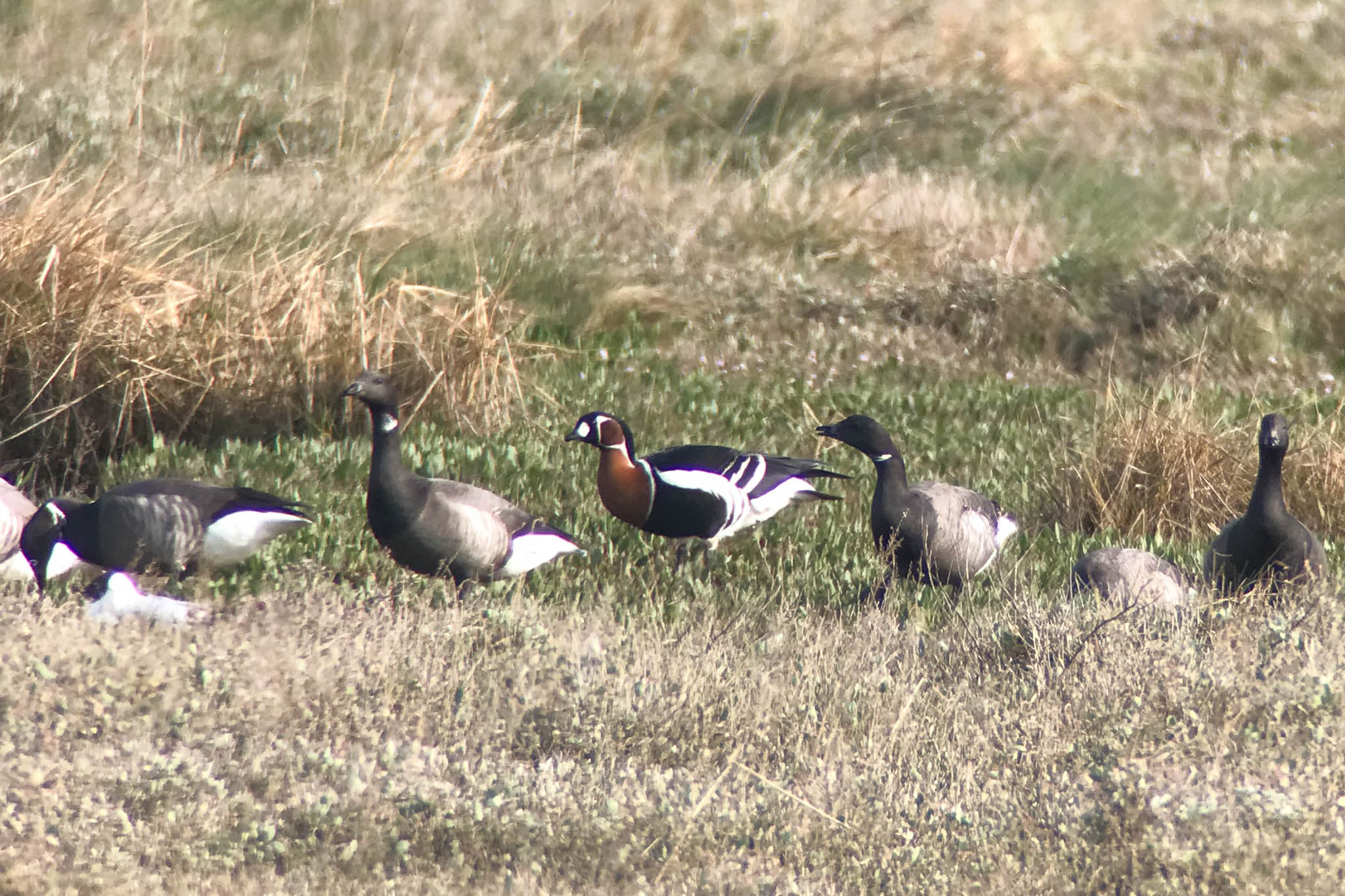
The Red-breasted Goose has been here for over three months now, with the wintering Brent Geese. The Brents should be leaving us soon, to head back up to Siberia for the breeding season and presumably the Red-breasted Goose with head back with them too. It was good that we were able to catch it again before it leaves – very helpful of it to linger!
There were several Redshanks out on the saltmarsh too, and a single Curlew. A Lapwing was displaying, flying backwards and forwards low over the ground singing, occasionally swooping up higher and twisting and tumbling.
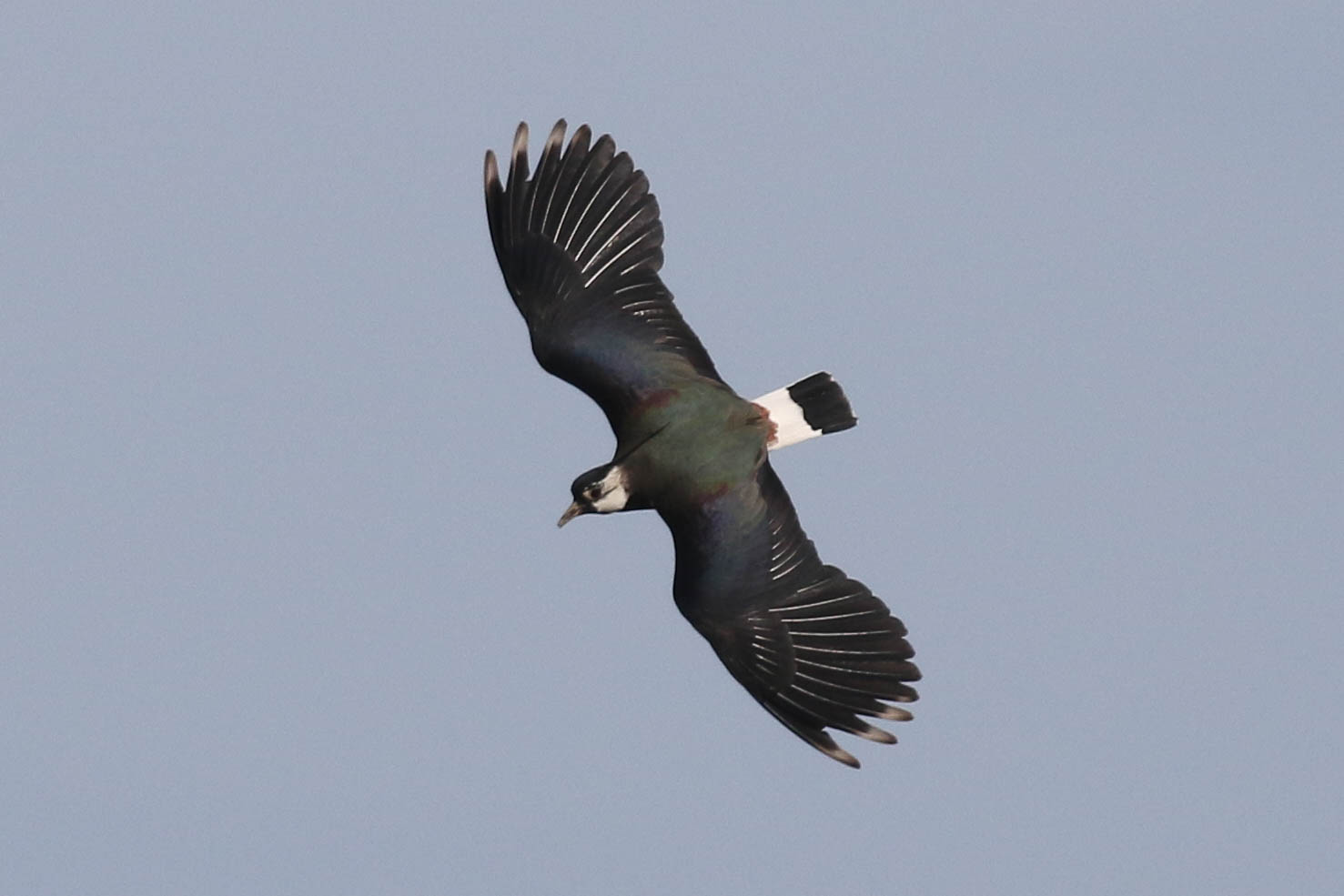
A Red Kite drifted out over the saltmarsh, hanging in the air and stooping down at one point after something. The Lapwing broke off from displaying to mob at it, swooping at the Red Kite repeatedly from above.

Having all had a really good look at the Red-breasted Goose, we walked back to the minibus. As we were packing up the scopes, two Mediterranean Gulls flew over us calling and disappeared off west. We made our way round to Cley next.
A couple of Greenfinches flew over the car park as we got out. We had just crossed over the road and turned to walk west along the Skirts when we received a message that a Golden Oriole had been seen flying west over Muckleburgh Hill, heading in our direction. We were not in the best place to scan from, but we stopped and looked for a few minutes. Unfortunately there was no sign, and presumably it headed inland along the ridge.
While we were looking, we did see two different Spoonbills which dropped out of North Foreland wood and down onto Pat’s Pool behind us. As we set off west again, another Spoonbill came right over our heads.

A Cetti’s Warbler started singing across the road and we looked over to see it perched up in the open in full view. Several times it disappeared in before coming out again to sing. Unusually good views of this normally very secretive species. Further on, a Common Whitethroat was singing its scratchy song from an elder bush on the edge of the reeds. A Cuckoo called from the edge of the wood somewhere out of view.

Up on the East Bank, we stopped to scan again. A Kestrel was hovering over the grazing marshes away to the east. There were lots of Swifts and hirundines, mainly Swallows and House Martins, moving again today. The Cuckoo flew back to North Foreland wood from further east over Snipe’s Marsh.
As we walked up the bank, we were just thinking how it wasn’t really a day for Bearded Tits given the wind, when we heard one call and looked over to see it fly off up the ditch below the bank. One called again, but still from the reeds just across the ditch from where we were and we looked down to see two juveniles creeping around in the vegetation. on far side of ditch.
It was sheltered down there, in the lee of the wind and the two young Bearded Tits eventually emerged out onto the edge of the reeds where they perched preening for several minutes. There was a Reed Warbler on the edge of the reeds too.
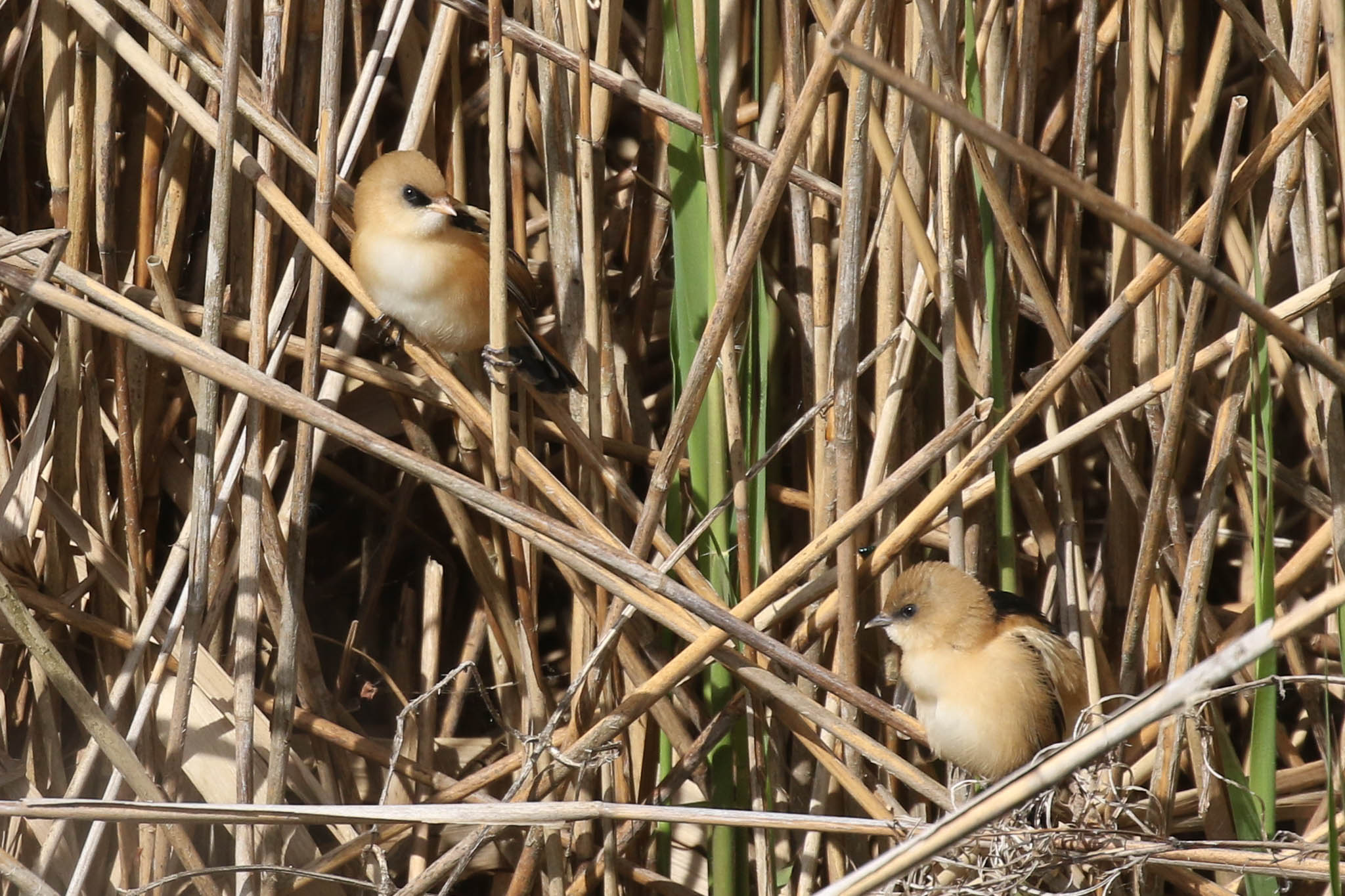
Looking out over the grazing marsh the other side, we found two Wigeon asleep in the grass on the edge of Pope’s Pool. Most have left already, back to Russia for the breeding season, but one or two often linger here for the summer. A Yellow Wagtail called as it flew over but we didn’t see it. Then a second Yellow Wagtail called and we looked up to see it as it came over our heads, but it continued on west without stopping too.
Two Ringed Plover down on the Serpentine looked like they might be northern passage birds, of the tundrae race, which pass through on their way north at this time of year. There were two Little Ringed Plovers as well – one was displaying back and forth over the water and then chased after the second. Two Turnstone were picking round the water’s edge.
Another Turnstone was feeding on the back of the Brackish Pools. There were two Little Terns and a single Sandwich Tern out here too, tucked down on the edge of the saltmarsh out of the wind.
We went into the shelter overlooking Arnold’s Marsh to get out of the wind – there were several Redshanks, Dunlin, Ringed Plovers and more Turnstones over towards the back. A group of about five Grey Plover included a couple of birds in smart breeding plumage, and two Golden Plover were roosting further over back in the saltmarsh vegetation. Two Bar-tailed Godwits were feeding on the water. A Whimbrel flew in from the east, but turned and dropped down towards the Serpentine. Then another Whimbrel came out from the vegetation on the edge of the water along with a Curlew.
Having come this far, we couldn’t not have a quick look at the sea. A couple of Sandwich Terns flew past close inshore but three Kittiwakes were much more. A small flock of Sanderling flew west too.
As we started to walk back, a message came through that a Honey Buzzard had been seen flying west past West Runton. We stopped to scan, just in case and then received another message that it was now over the sea off Salthouse. As we turned round to head back to the beach, an update told us it was now heading inland and away from us, back over Kelling village. It seemed like it may have gone the wrong way!
We stopped again and scanned the ridge inland, and it wasn’t long before we picked up the Honey Buzzard now high up just south of Walsey Hills. We got it in the scopes and all had a look at it before it dropped down and back over the ridge. Presumably it had just seen a thermal, because a minute later it reappeared over North Foreland Wood. It circled up and was mobbed by a Common Buzzard, before gliding quickly off west behind Cley.
As we set off back again, two Red Kites flew in over the fields and across the reedbed. Two Common Sandpipers had appeared now on the Serpentine, and what was presumably the Whimbrel we had seen flying in earlier was now in the grass beyond. A Sedge Warbler was singing in the reeds as we passed, showing off its bright orange gape.

As we made our way back along the Skirts path, one of the group noticed a large Drinker Moth caterpillar on the reeds by the path. Then it was back to the Visitor Centre for an early lunch. It was just sheltered enough from the wind to sit in the picnic area, from where we could look out over the marshes. A Marsh Harrier circled over the reeds in front and a Little Ringed Plover flew round over the car park, presumably looking to see if the gravel was a suitable nesting site again.
As we were finishing up, two Yellow Wagtails flew in and landed briefly on one of the islands on Pat’s Pool. We could just see one of them in the scope through the tops of the reeds before they took off again. They circled round, went to look at the cows on the neighbouring grazing marsh, then flew back and landed out of view behind the reeds.
Two Yellow Wagtails flew in, landed briefly on island on Pat’s. Could just see in scope through tops of reeds. Flew, circled round, went to look at cows, then flew back and landed behidn reeds possibly on Simmond’s.
There didn’t seem to be much on the scrapes today but there had apparently been some Wheatears out on the beach earlier, so we headed round to the beach car park now. Walking out along the edge of the Eye Field, we scanned the fence posts and the grass. We couldn’t see any Wheatears but we did find a Golden Plover out in the field, possibly one of the two from Arnold’s earlier.
We stopped to scan Billys Wash from the top of the Eye Field. There wasn’t anything on the mud there but we did spot a large flock of small waders which landed beyond, on Simmond’s Scrape. It was too far away to see what they were, but when they took off again they flew round over the Eye Field. A mixed flock of Dunlin and Ringed Plover, then they headed off west up the Point. There didn’t look to be anything on North Scrape either, so we turned to head back. A Redshank was calling from one of the fence posts back by the car park.

Our next destination was Kelling Water Meadow, where we figured it might be a little more sheltered. It was sheltered in the lane and there was a nice selection of butterflies around the flowers, Small & Green-veined Whites, Orange Tip, Wall, Peacock and Small Tortoiseshell. A male Blackcap was singing and a female showed briefly on the edge of one of the hollies. We could hear a Chiffchaff in the hedge a little further along.
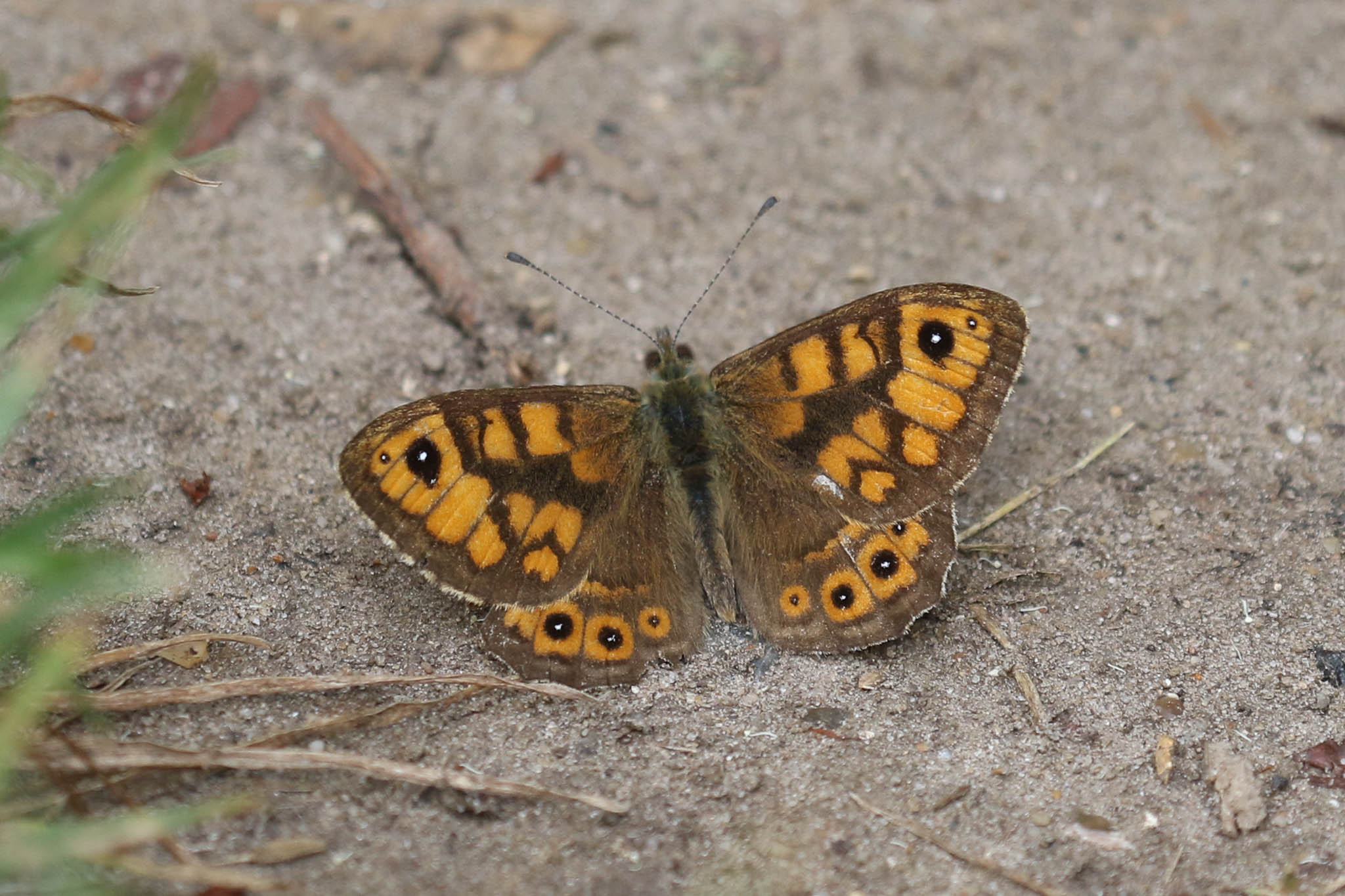
Continuing on down to the Water Meadow, we couldn’t see any cows from the gate. We heard a Yellow Wagtail call as it flew off west and when we got down to the crosstrack and looked back we could see why it hadn’t lingered – the cows were lying down behind the hedge! We had hoped we might get some wagtails on the ground with the cows here, but not with the cows lazing around.
There were lots of Gadwall and a pair of Shoveler on the pool and an Egyptian Goose on the bank. We heard a Cuckoo calling and turned to see it flying east over the Quags, continuing on and away over the Camp. As we walked down towards the Hard, several Linnets flew over and a male Stonehcat perched up briefly.
Up towards the gun emplacements, we once again lamented the dumping of building rubble on Weybourne Camp, where the orchids used to grow. There were three or four Linnets and a pair of Red-legged Partridges which at least seemed to appreciate the rubble. There were a few Brown-tail Moth tents on the remaining blackthorn bushes which haven’t been grubbed out. A couple of Sandwich Terns flew past over the sea.
There were no signs of any migrants here, so we headed back. When we got back to the village, a Goldcrest was singing in he fir tree by the school and dropped down to bathe in the beck before flying up into the hedge right beside us.
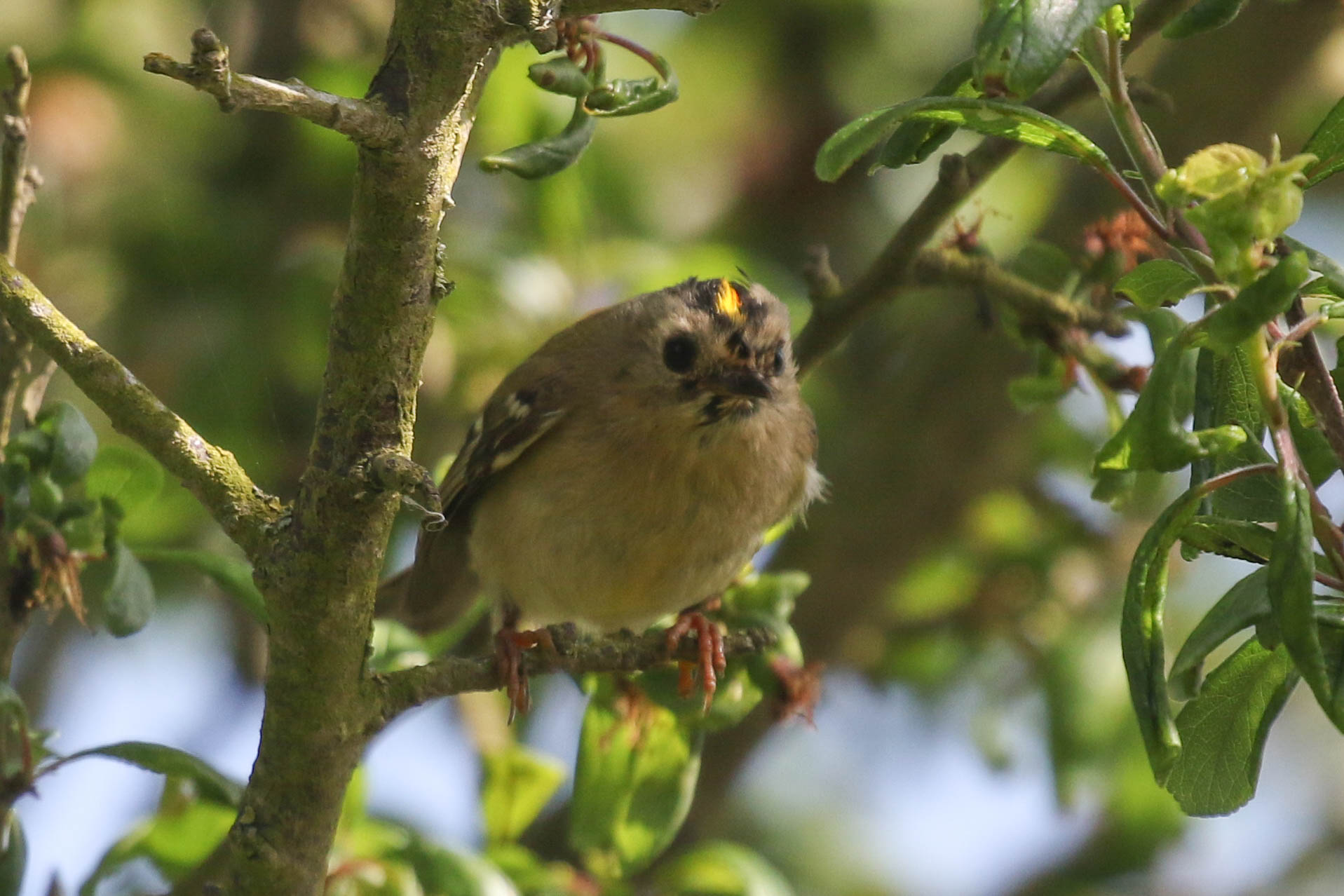
We called in at Stiffkey Fen to finish the day. A Yellowhammer was singing from the hedge beside the road as we crossed over, but tucked down somewhere out of the wind. As two Common Buzzards hung in the air over the copse a male Marsh Harrier circled up from below calling and had a go at one of them. A female Marsh Harrier came up too.
From the path alongside the river, we looked over to the Fen. A Common Sandpiper was out on the mud and a Marsh Harrier circled over the reeds before landing in a bush. A Willow Warbler was singing in the sallows.
From up on the seawall, we could see there were actually two Common Sandpipers on the Fen. But there was just one Black-tailed Godwit, admittedly very smart in breeding plumage. There had clearly been a clearout of waders in recent days, as they headed off north to breed, and there were fewer birds here than of late. A Great White Egret was standing on the mud in the corner preening, and helpfully had a Little Egret nearby to provide a nice size comparison.

Looking out towards the harbour, there were still good numbers of Brent Geese on the saltmarsh, and just a couple of seals on the end of the Point, along with a big flock of Sandwich Terns which flew up and circled round. A steady succession of Swifts and hirundines were still flying past, as they had been pretty much all day, migration in action.
We walked round to look out across the harbour channel. As we did, two more Common Sandpipers flew out from the edge and across the water ahead of us. A Brown Hare was basking on the private track beyond the gate.
There were lots of gulls on the mud in the harbour, moving up ahead of the rapidly rising tide. As well as lots of Great & Lesser Black-backed Gulls, Herring Gulls and Black-headed Gulls, there were several Common Gulls, mostly 1st summers but with one smart adult, and a single 1st summer Mediterranean Gull.
There were still a few waders beyond, gathering to roost over high tide. A smart rusty summer Bar-tailed Godwit was fast asleep. Nearby, there were a few Grey Plover, Dunlin, a Curlew and a small group of Oystercatchers. There were more small waders on the shingle spits out in front of us – lots of Ringed Plover, Dunlin and a few more Turnstones.
It was a lovely spot to stand and stare out over the harbour, but it was time to head back now. Another Cuckoo was calling in the poplars beyond the Fen and back along the path by the river we could see the Willow Warbler singing now. Further along, beyond the kissing gate, a Chiffchaff was singing in the trees above our heads. We stopped to admire a couple of Small Eggar moth caterpillar webs in the hedge.
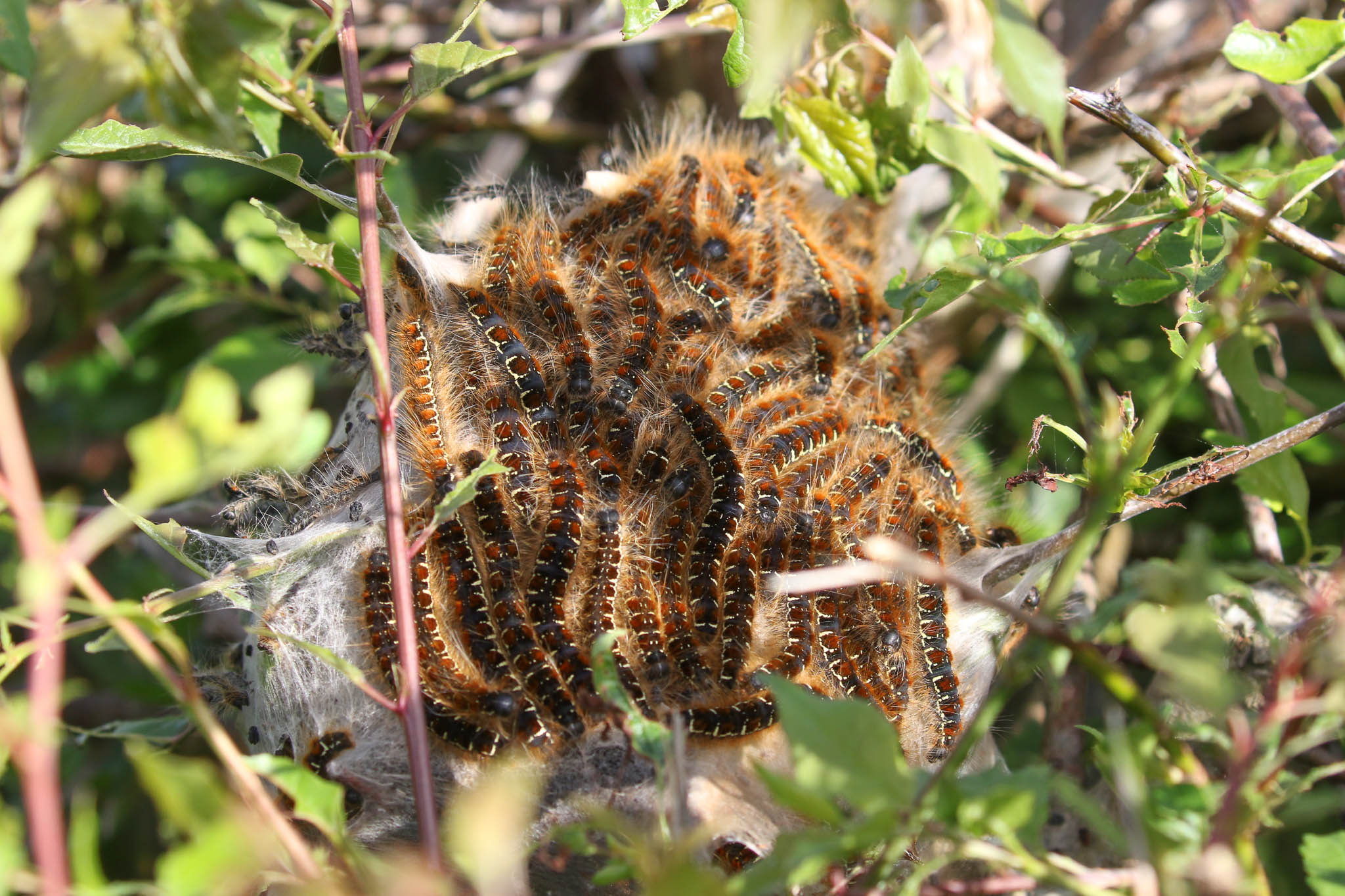
It had been another interesting day of Spring migration on the coast – wonder what tomorrow will bring?
















